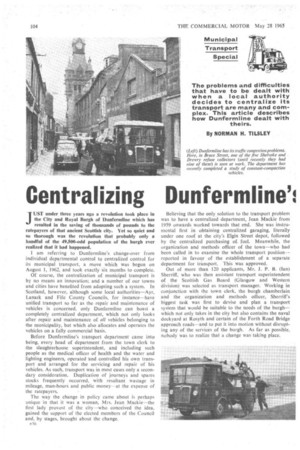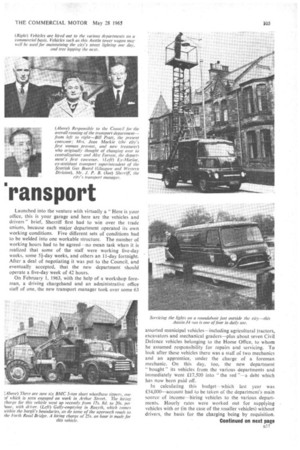Centralizing Dunfermline': 'ransport
Page 106

Page 107

Page 108

If you've noticed an error in this article please click here to report it so we can fix it.
By NORMAN H. TILSLEY JUST under three years ago a revolution took place in the City and Royal Burgh of Dunfermline which has resulted in the saving of thousands of pounds to the ratepayers of that ancient Scottish city. Yet so quiet and so thorough was the revolution that probably only a handful of the 49,500-odd population of the burgh ever realized that it had happened.
I am referring to Dunfermline's change-over from individual departmental control to centralized control for its municipal transport, a move which was begun on August 1, 1962, and took exactly six months to complete.
Of course, the centralization of municipal transport is by no means an innovation; and a number of our towns and cities have benefited from adopting such a system. In Scotland, however, although some local authorities—Ayr, Lanark and Fife County Councils, for instance—have unified transport so far as the repair and maintenance of vehicles is concerned, only Dunfermline can boast a completely centralized department, which not only looks after repair and maintenance of all vehicles belonging to the municipality, but which also allocates and operates the vehicles on a fully commercial basis.
Before Dunfermline's transport department came into being, every head of department from the town clerk to the slaughterhouse superintendent, and including such people as the medical officer of health and the water and lighting engineers, operated 'and controlled his own transport and arranged for the servicing and repair of his vehicles. As such, transport was in most cases only a secondary consideration. Duplication of journeys and spares stocks frequently occurred, with resultant wastage in mileage, man-hours and public money—at the expense of the ratepayers.
The way the change in policy came about is perhaps unique in that it was a woman, Mrs. Jean Mackie—the first lady provost of the city—who conceived the idea, gained the support of the elected members of the Council and, by stages, brought about the change.
Believing that'the only solution to the transport problem was to have a centralized department, Jean Mackie from 1959 onwards worked towards that end. She was instrumental first in obtaining centralized garaging, literally under one roof at the city's Elgin Street depot, followed by the centralized purchasing oE fuel. Meanwhile, the organization and methods officer of the town—who had been called in to examine the Whole transport position-reported in favour of the establishment of a separate department for transport. This was approved.
Out of more than 120 applicants, Mr. J. P. B. (Ian)
• Sherriff, who was then assistant transport superintendent of the Scottish Gas Board (Glasgow and Western division) was selected as transport manager. Working in conjunction with the town clerk, the burgh chamberlain and the organization and methods officer, Sherriff's biggest task was first to devise and plan a transport system that would be suitable to the needs of the burgh— which not only takes in the city but also contains the naval dockyard at Rosyth and certain of the Forth Road Bridge approach roads—and to put it into motion without disrupting any of the services of the burgh. As far as• possible, nobody was to realize that a change was takiti-g place.
Launched into the venture with virtually a " Here is your office, this is your garage and here are the vehicles and drivers" brief, Sherriff first had to win over the trade unions, because each major department operated its own working conditions. Five different sets of conditions had to be welded into one workable structure. The number of working hours had to be agreed—no mean task when it is realized that some of the staff were working five-day weeks, some 5i-day weeks, and others an 11-day fortnight. After a deal of negotiating it was put to the Council, and eventually accepted, that the new department should operate a five-day week of 42 hours.
On February 1, 1963, with the help of a workshop foreman, a driving chargehand and an administrative office staff of one, the new transport manager took over some 63 assorted municipal vehicles—including agricultural tractors, excavators and mechanical graders—plus about seven Civil Defence vehicles belonging to the Home Office, to whom he assumed responsibility for repairs and servicing. To look after these vehicles there was a staff of two mechanics and an apprentice, under the charge of a foreman mechanic. On this day, too, the new department bought" its vehicles from the various departments and immediately went £17,500 into "the red "—a debt which has now been paid off.
In calculating this budget—which last year was f54,000—account had to be taken of the department's main source' of income--hiring vehicles to the various departments. Hourly rates were worked out for supplying vehicles with or (in the case of the smaller vehicles) without drivers, the basis for the charging being by requisition, Charging was achieved by transfer of the appropriate amount through the chamberlain's office, departments being notified monthly of the amounts debited to them.
To assist with administration, all vehicles were allocated a fleet number and files were started for each one containing a complete history of the vehicle—the number of services and overhauls that it had had and any repair or accident work Carried out. Accident reports and any other correspondence was also kept in the file.
Coinciding with the formation of the new department, a 20-foolscap-page document entitled "Transport Department Administrative Instruction" was forwarded to the heads of every department within the Corporation. Compiled by the transport manager, it gave details of how the department was made up, what transport it provided and how it could be obtained. It gave other details, too, appertaining to the drivers—how they were to be engaged, what documents they had to complete, and so on; and it also dealt with traffic operation, garaging, legal hours of work and the procedure for reporting accidents.
Prefacing these instructions was a section in which the manager stated that centralization of transport would, in
time, show its own results. How long this may take and what these results will be, depends largely on how efficiently I, as manager, can operate my department, and how co-operative the user departments will be." The introduction continued: "Having met all my colleagues, I feel sure I can look for 100 per cent co-operation and, given that, the rest is my responsibility. While I can promise WO per cent effort in every case, I cannot promise 100 per cent efficiency immediately," Sherriff went on to say that he hoped in the course of time to dispel any doubts regarding his new organization.
Those early days of the department are now history so far as Dunfermline is concerned. The co-operation that Ian Sherriff called for was, in fact, forthcoming—helped along by the then convenor of the department, Mr. Alec Forrest, and the lady provost, Jean Mackie.
Today the city's transport is running smoothly. The vehicle strength has been reduced by 25 per cent and man1138 power by 121 per cent. Operating costs have been brought down to Is. 10d. per mile, and stores carried in stock, amount to 050—about ft 1 per vehicle. A careful watch is kept on vehicle performance—a task made easy by the use of performance record sheets which are completed each Monday.
All mechanical repairs and overhauls, other than to bodywork and painting, are carried out by the department's own small staff. The vehicles are now serviced every 28 days, on a 1,000-mile, 1,000-mile, 3,000-mile, 1,000-mile, 1,000-mile, 6,000-mile-service rOtation, whether, they have covered this mileage or not. "It is better for them to be over-serviced than under-serviced ", Sherriff told me.
AUTOMATIC LUBRICATION
Vehiclesof more than 2 tons carrying capacity which have been purchased within the past two years are fitted with automatic lubrication. The cost of this equipment works out at 6id. per 1,000 miles, including the initial cost of the equipment. Within the garage premises is a washbay, and the vehicles are washed every evening after use. The depot at Elgin Street also has its own fuel bunkers and a public weighbridge.
Except in emergency, vehicles are only supplied to the various departments after the completion and signature by the head of the department, or his nominee, of a requisition form, which must be submitted to the transport department not later than 3 p.m. on the day prior to that of requirement. Made up in three parts, the form gives details of the type of vehicle required (which is completed by the department requiring the vehicle), the vehicle and driver allocated (completed by the transport manager) and, Ethel the job has been completed, the number of hours worked which is completed by the driver. in cases of emergency, telephone requests are accepted.
The workshop and garage is manned from 7.30 a.m. until 11 p.m. on weekdays and 4 p.m. on Saturdays—a backshift driver being employed during the evenings. At all other times a standby driver is available, on telephone call. So that calls can be taken when the duty driver is out on a job, an answering machine has been installed at the depot.
DRIVING TESTS •
Before any employee or official of the burgh is allowedto drive one of the department's vehicles, he must be tested and authorized by the transport manager. Nearly 200 people, including midwives, children's officers and so forth, have been tested and hold special Dunfermline driving licences, and for every authorized driver a record card is kept on which accidents are recorded, whether the driver was blameworthy or not.
Transportwise, since centralization was brought in Dunfermline has never looked back. Modern vehicles are being brought into use—for instance, the department is awaiting delivery of a Johnston suction cleaner which, based on a BMC chassis, has a double sweep and will replace the conventional brush cleaner. Last month the department completed a study of constant-compaction vehicles, road tests having been carried out on several varieties of refuse collectors.
From conversations I have had with members of the Council and the public, I gather, that not only has Ian Sherriff fulfilled his promise of a 100 per cent effort, but he has gone a long way to achieving that 100 per cent efficiency. too,








































































































































































